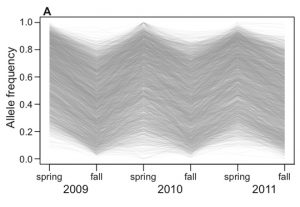Guest post by Julia Kreiner. #TAGC16 Shorts are brief summaries of presentations at The Allied Genetics Conference, a combined meeting of seven genetics research communities held July 13-17, 2016 in Orlando, Florida.
A common perception of evolution sees only slow and consistent genetic change over thousands of generations. But geneticists are increasingly shedding light on examples of evolution over ecological timescales — genes tracking changes in the environment. At The Allied Genetics Conference, Emily Behrman (University of Pennsylvania) revealed that adaptation can occur even faster than we may have expected. Her findings show changes in the frequency of Drosophila life history phenotypes and the underlying genes are associated with changes in selection pressures between seasons.
In Behrman’s long-term data set, allele frequencies and the fitness of phenotypes change seasonally, on a scale comparable to the differences caused by living in distant geographic regions. During the summer, phenotypes that can exploit the undemanding conditions are favored, but winter selects for those that can best withstand harsher conditions. This is seen as stabilizing selection over years. Traditional examinations that use such longer time scales would detect only stabilizing selection, masking the finer scale fluctuating dynamics. Behrman interprets these dynamics of selection as playing an important role in maintaining variation in natural populations. This principle is likely true not only in fruit flies but across a wide variety of taxa.

Allele frequency change at ∼1750 seasonal SNPs. From Bergland et al.
TAGC Program number P332
Dynamics of seasonal adaptation in Drosophila melanogaster.
Emily L. Behrman1, Alan O. Bergland2,3, Dmitri A. Petrov2, Paul S. Schmidt1.
1) University of Pennsylvania, Philadelphia, PA; 2) Stanford University, Stanford, CA; 3) University of Virginia, Charlottesville, VA.
Further reading: http://onlinelibrary.wiley.com/doi/10.1111/jeb.12690/abstract
About the author: Julia Kreiner is a graduate student at University of Toronto studying the rapid adaptation of herbicide resistance, a burnt out athlete, and a nature lover.













